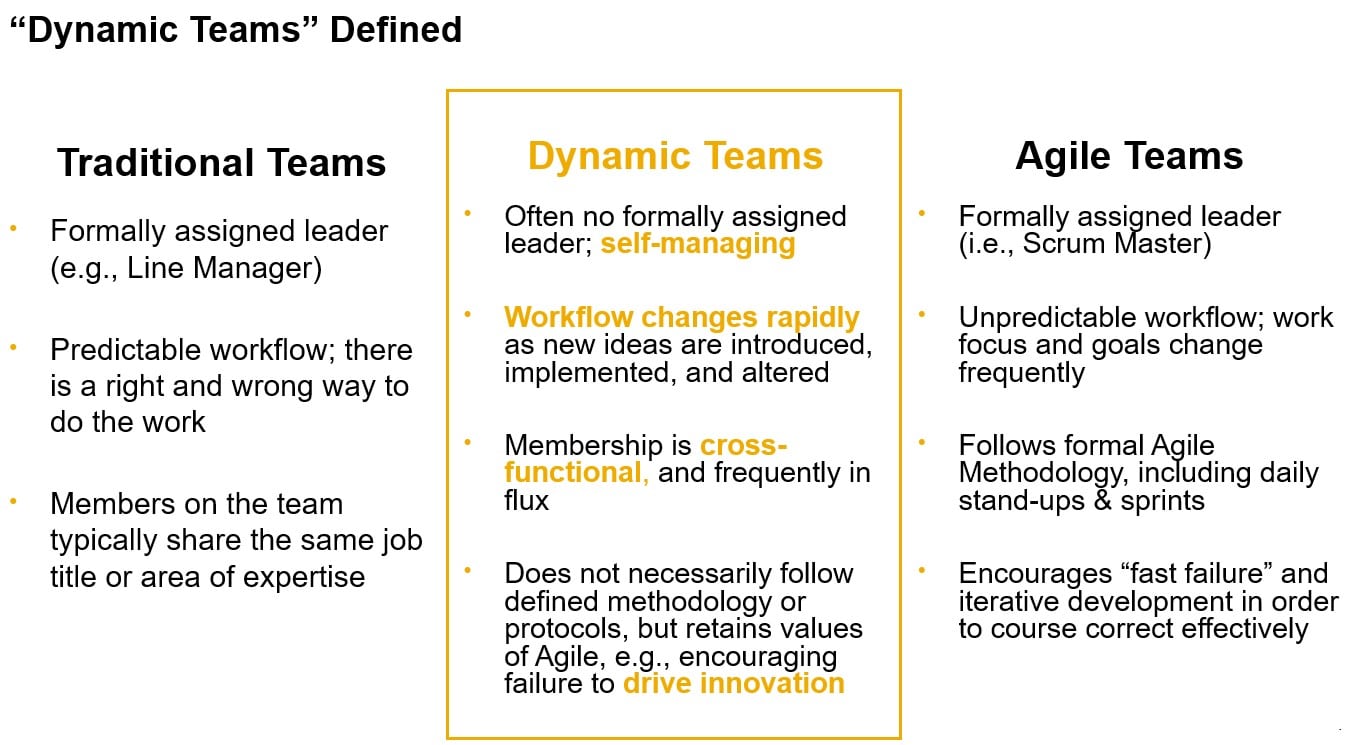Due to the digital revolution, work is changing faster than ever before. Many jobs and work tasks will be eliminated or to some degree altered by the rise of intelligent technologies, and it is estimated that by 2022 up to 54% of all employees will need to re- or upskill.
In this environment of rapid change, it is imperative that organizations become more adaptable and agile in order to maintain a market advantage. Although most companies view organizational agility as a key initiative, few feel as though they are ready to face that challenge in their current state.
This is because the way organizations are traditionally organized works against this very goal. Steep hierarchies and departmental silos encourage employees to not speak up or go against the grain, causing organizations to carry on “business as usual” without appropriate knowledge regarding failures or shortcomings.
It is for this reason that some organizations are choosing to completely reimagine the way that work gets done. There is a cultural shift occurring that is de-emphasizing “jobs” while emphasizing the work that needs to get done and the skills that are needed to complete the work in the most optimal way.
One essential component of this work revolution is gaining the ability to “team” in a dynamic way. A Dynamic team may not exist on an organizational chart or have a formally assigned leader, but there is a common purpose, a common goal, and work that needs to get done.
I recently sat down with Caitlynn Sendra to discuss these “Dynamic teams.” Sendra is an HR research analyst on the SAP SuccessFactors HR Research Team, leading the Enabling Dynamic Teams research program. The purpose of this applied research program is to better understand and enable Dynamic teams to be effective and successful.
Q: There seems to be some confusion around terminology. What exactly is a Dynamic team? How does a Dynamic team differ from Agile teams?
A: Great question. We have defined Dynamic teams as a broad, umbrella term, which generally describes teams that do not exist on an organizational chart, but rather are naturally formed by a group of people coming together to get work done.
A good example I like to use is the numerous “COVID-19 response teams,” which were built rapidly order to address the COVID-19 crisis. These teams tend to be self-managing, cross-functional, and are tasked with doing types of work that do not have one “right answer.” Of course, Dynamic teams are “agile,” meaning they are efficient and adaptable, but they are not “Agile,” which causes confusion.
Agile teams are teams that specifically follow the Agile methodology. Agile teams are typically more rigid in their structure, are characterized as having defined roles and processes, and almost always have formally assigned leaders. In speaking to customers, we see many business leaders saw the benefits of Agile teams and sought to implement them into other departments, such as recruiting, marketing, sales, and HR.
However, the Agile methodology was created to suit a very specific context and did not always translate perfectly. The result of this is that many departments kept the parts of Agile they liked while ditching the parts they deemed unnecessary. For this reason, many of the Dynamic teams we see utilize some Agile terminology (such as, calling the teams “squads”), but aren’t truly Agile teams.

If Dynamic teams are necessary for driving adaptability and innovation, what is stopping companies from leveraging Dynamic teams?
Unfortunately, despite the benefits of Dynamic teams, there are many barriers that exist both from an employee and HR perspective that prevent organizations from leveraging these sorts of teams effectively. All of our HR systems and technologies have been created with individuals and traditional teams in mind. From the HR perspective, we hear a lot of concerns about visibility. If the team doesn’t exist on the organizational chart or in any HR system, how can we track performance, distribute rewards, or provide feedback?
From the employee’s perspective, the biggest challenges are much more tangible in nature. When teams need to come together quickly to get work done, there often isn’t time to get to know one another, to understand everyone’s backgrounds and expertise, or to agree upon tasks, roles, and processes. Additionally, people participating in Dynamic teams are typically balancing the demands of the team with the demands of their “traditional job role.” When their performance on the team isn’t linked to their KPIs, it can be easy for the team’s demands to become less of a priority.
The result is that Dynamic team experiences can feel chaotic, disjointed, and unorganized. In order to begin to leverage these teams successfully, we need to start building technologies and processes to support them appropriately.
You mentioned how technology may help improve the experience for Dynamic teams. What sort of technology could help to enable these teams?
From the HR perspective, technologies such as opportunity and talent marketplaces can help to connect some of the dots in terms of sourcing and tracking these teams. However, from the employee perspective, we really need to go back to basics. Dynamic teams can really leverage technologies like SAP Work Zone for HR, which can provide them with a space to come together to find experts, collaborate and share knowledge, come to an agreement about goals, roles, and processes, and get work done.
Due to the intuitiveness of SAP Work Zone for HR, Dynamic teams can define what content should remain within the team and what can be shared publicly and communicated accordingly. This kind of technology can also help to provide managers with insight into the work that their direct reports are doing on Dynamic teams so they can better leverage that information when providing rewards and recognition.
To learn more about our research on Dynamic teams or any other of our research programs, please check out our SAP SuccessFactors HR Research Community page.
Also plan to hear Sendra and Stephanie Craig from SAP Solution Marketing talk more about this topic during a LinkedIn Live event by SAP SuccessFactors on February 23, 2021.



